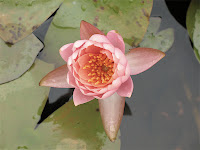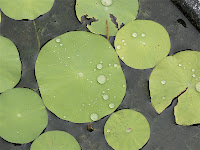 Get Your Sunscreen on and Head Outside
Get Your Sunscreen on and Head OutsideLet's begin with picking some
ripe, delicious blueberries. This post is by one of my favorite
bloggers,
cloudscome, who writes awesome haiku poems accompanied by some amazing nature photos at her blog,
a wrung sponge.
When outdoors, always keep your eyes open, as you never know what you might see. Oh, look over there! It's
that darn snake! Over at
Po Moyemu, Sylvia not only writes about the snake that can't seem to stay away from the hen house, but also shares this
Odd Egg Update.
Would you like to
explore colors in your garden? Barb at
The Heart of Harmony shares this nature activity from
kidsgardening.org. Another great idea from Barb is on
how to make a nature journal. This one has great pictures that show the process step-by-step.
I love my nature notebook, as it often helps me remember where I've been and what I've seen. Over at
Backyard Birding, Dana shares some thoughts on
notebooks and birds.
Speaking of birds, I'm crazy about them. I recently discovered the blog of a
Bird Study Ecology Group. Okay, I know these folks are in Singapore, but the pictures are terrific and I'm learning quite a lot about bird behavior. Check it out and see what you think.
With fall fast approaching, now is a good time to think about making your yard a bit more nature-friendly. Tiffany at
Natural Family Living shares a slide show that highlights their
backyard wildlife habitat.
Well, I thought mountain climbing in Tibet was adventurous, but it seems that Stephanie over at
Adventures in the 100 Acre Wood has me beat! Read all about the
Infamous Alaskan Backpacking Trip. (If you want to read about that mountain in Tibet,
follow this link.)
For a trip closer to home, the folks at
Free Range Academy share their pictures of a recent trip to the
Lynde Shores Conservation Area.
Over at the
Yellow House Homeschool, nature walks are a way of life. Check out the
prairie walk, the
tree study, and
plant things. If you want to learn to take better nature photos, be sure to read the entry entitled
Scale Matters.
Dawn at
By Sun and Candlelight often shares shares pictures and writes about the flora and fauna that surround her family. I love this entry entitled
Little Nature Stories: Birds, Bugs and Berries.
I'm always on the lookout for a new blog (at least new to me) that celebrates nature. Join me in visiting one of my new faves,
Beyond the Fields We Know. The photos of this little corner of Ontario are amazing. While you're visiting, be sure to reflect on the passing of July with the entry entitled
The Blessing Moon of July.
Let's Head Back in to Find Some Good BooksBecky at
Becky's Book Reviews shares
Shape Me a Rhyme, a poetry book written by Jane
Yolen and illustrated with photographs by her son, Jason
Stemple.
Would you like to learn about
worms? Julie at
Pines Above Snow shares some great reads for those with more than a passing fancy. If you want to follow up these books with a great online resource, I'm partial to the
UIUC site
The Adventures of Herman the Worm.
Over at
True Colors,
Dawnelle introduces us to the book
Handbook of Nature Study by Anna
Botsford Comstock. Using this same title,
Lindafay at
Higher Up and Further In writes about using this book to guide their study of butterflies.
Funding and a Bit O' PoliticsSometimes finding money for outdoor education can be a problem. Terrell from
Alone on a Limb and the inventor of this here blog carnival shares a fantastic
proposal for a nature study project.
Given all the federal mandates mucking up public education these days, I'm not one for adding even more requirements, but this one has me nodding my head in agreement. If you haven't read about the proposed addendum to
NCLB entitled
No Child Left Inside, please do.
Just for FunOn July 7
th, the New 7 Wonders Foundation announced the winners of a global vote on the New 7 Wonders of the World. You can
read about it here. The Foundation has now set off on a campaign to nominate the sites for the
New 7 Wonders of Nature. Where in this big beautiful world have you been that is a worthy nominee? Think about it and then head on over and nominate your favorite spot.

That's it for this edition. Thanks so much for visiting. I leave you with and excerpt from
Ordinary Things: Poems From a Walk in Early Spring by Ralph Fletcher, for it's also time for me to leave my desk behind. Enjoy!




This is such an awesome idea. I think I'll wear my FROG/TOAD bracelet that day and leap into a new book. (Or re-read Frog and Toad. You can't read any of those books too many times.)
What a fun idea. I also recommend A Toad for Tuesday Russell E. Erickson and Lawrence Di Fiori.
Tricia,I'm not sure what I'll be doing on leap day--maybe looking through my library collection for all my frog and amphibian books! Here are a few more book suggestions:- "Red-Eyed Tree Frog" by Joy Cowley- "The Frog Prince Continued" by Jon Scieszka- "The Prince of the Pond" by Donna Jo Napoli. It's a chapter book with a frog prince motif--but it's much more than a play on the traditional tale.
I LOVE Scieszka's book and completely forgot about it. We also have Florian's book, so I'll need to add those to the list. Thanks for the additional suggestions. I just may need to put an annotated list together!
What a timely post! There's a tv series about reptiles and amphibians on in the UK at the minute, and the stories about disappearing frogs are awful, so sad. I'm currently reading You Darkness by the Haitian author Mayra Montero, which is largely about the search for disappearing frog species. I'm going to review it on my blog when I've finished and would like to link to this post of yours if